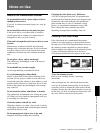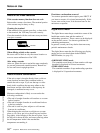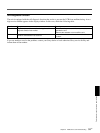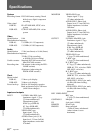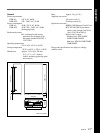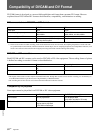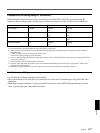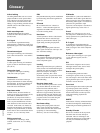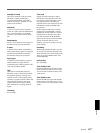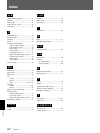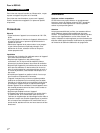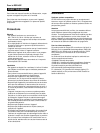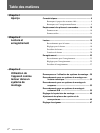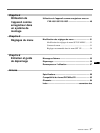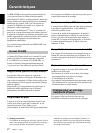
Appendix
Appendix 65
GB
Standby On mode
One of two conditions in the stop mode.
The drum is rotating and the tape is
wrapped round the drum. The VCR is
ready for recording or playback, so a still
picture can be obtained.
Subcarrier
A sine wave imposed on the luminance
portion of a video signal and modulated to
carry color information. Its amplitude
represents color saturation and its phase,
hue.
Superimpose
To put a set of characters onto a picture so
that both can be seen at the same time.
S-video
A signal format in which Y (luminance)
and C (chrominance) signals are separated
to reduce interference between them so
that noiseless images are reproduced.
Sync signal
A reference signal consisting of vertical
and horizontal sync signals used for
synchronizing the scanning patterns of the
video camera and the monitor.
TBC
Abbreviation of Time Base Corrector.
Electronic circuits to electrically stabilize
the playback signals by removing color
variation and roll in the playback picture
caused by irregularity in drum rotation and
tape movement. Time base correction
reduces deterioration of picture quality
when transmitting or copying playback
signals.
Threading
See “Loading”.
Time code
Signals recorded on the tape to supply
information on tape position such as the
hour, minute, second and frame, to assist
in setting edit points or searching for
particular scenes. This VCR can cope with
both DF (Drop Frame) and NDF (Non
Drop Frame).
On this VCR, the time code is recorded
sequently from “00:00:00:00,” from the
beginning of the tape. However, if there is
a blank section on the tape, time code is
reset and recorded from “00:00:00:00”
again from the section just after the blank
section. If the time codes are out of
sequence, you may not be able to execute
correct editing.
Unloading
When being unloaded, the tape is put into
the cassette case from the tape path of the
VCR. Generally, this is done automatically
when you press the EJECT button. Also
called unthreading.
Unthreading
See “Unloading”.
12bit (Fs32k) mode
In the DVCAM format, the 12bit (Fs32k)
mode separates the audio area into 2 parts.
You can record two kinds of audio, stereo
1 and stereo 2.
16bit (Fs48k) mode
In the DVCAM format, the 16bit (Fs48k)
mode uses the whole audio area to record
one stereo track. You can get higher sound
quality.



